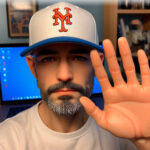Making Waves
A definition of the word “wave” according to the American Heritage Dictionary is:
- “To make a signal with an up-and-down or back-and-forth movement of the hand or an object held in the hand.”
When I was about twelve years old, my father said something to me to which I decided to reply with a simple hand wave. You know the kind, A downward flick of your fingers, the one you would use for “It’s not important” or “Don’t worry,” which was what I meant to say, though it could have also been interpreted as “go away.” To my father, it meant none of those; he was furious with me and probably would have slapped me for being so impertinent. Little did I know that where he grew up in Germany, that hand signal was the equivalent of giving him the finger using present-day hand gestures.
Hand waves have many meanings, depending on who is the sender and what the intent is.
A wave of the hand from side to side can mean saying goodbye or greeting someone or a location beacon to specify where you are to someone farther away.
A sideways back-and-forth wave when you are in a car and stopped might indicate that it is okay for a pedestrian to pass, with a promise that you won’t run them over. (Note that not everyone uses this signal. My wife, for example, uses a front facing palm-up hand held still for the same intent.)
Traffic police or school crossing guards use a variety of hand motions to control traffic. For example, holding one hand facing you and continuously curling and uncurling fingers signals one can move forward or cross the street if you are a pedestrian. A palm-facing hand or hands held up towards you with no motion definitely means to stop.
Military and Aviation signals involve waving hands, flags, or flashlights to communicate instructions or commands.
Sometimes, you only use one finger or two, whether it be the thumb pointing up or down at the end of a closed fist to represent approval/disapproval, two fingers representing the letter “V” can mean victory or peace, or a single finger, usually pointed up usually is a scolding, a reprimand, or just a strong opinion of a person, or their ideas. These sometimes get responses similar to yours in intensity right back to you.
Raise your hand in a restaurant with a two-finger wave to signal you want some attention, perhaps a check or food. It could also mean, “Are you ever going to take my order and serve me?” A displeased facial expression usually accompanies this.
Fluttering your fingers in a wave might be construed as flirting, depending on who receives the wave.
If you were trapped on a desert island as a plane flew by or a ship was within view and you vigorously waved both hands over your hands, that would be a clear signal (if you were seen) that you needed help.
In sporting events or celebrations, waving hands can signify encouragement, support, or enthusiasm. In fact, at some events, fans standing up and down sequentially and waving their hands up and down can as the stand and sit represent a different kind of wave, an ocean wave.
Sign Language involves another use of hand waving. Many different signs signify words and phrases using hand movement and position. Some American Sign Language (ASL) examples include the signs for hello, goodbye, come here, go away, yes, wind (the blowing kind), applause, airplane, thank you, and wave. Be careful if you attempt to use ASL in another country. Not all sign languages use the same signs. A sign that means one thing in America might mean something totally different in a foreign country, as did the one I used on my father, what I thought was a simple hand gesture.
Some exaggerated hand waves, in certain contexts, can even be considered mockery or ridicule of a person, their beliefs, or their individual lifestyle. These are the worst, in my opinion, and say a lot about the individual using them if their intention was deliberate.
With all this in mind, and a lot more that I don’t want to take the time to discuss, be careful and thoughtful whenever you make waves. Ensure your wave’s intent is communicated correctly to the person you’re waving to. And use them positively, PLEASE.
I leave you with some quotes about how some wave-making wasn’t quite received as intended, though in a comical way.
“I’ve waved at people I thought were waving at me, only to realize they were just scratching their heads or swatting flies.” – Steve Martin, American actor and comedian
“I made the mistake of waving at a squirrel once because I thought it was a person. I need to get out more.” – Zach Galifianakis, American actor and comedian
“I waved at a garden gnome in someone’s front yard thinking it was a small child. I need to get my eyes checked.” – Aziz Ansari, American actor and comedian
“I once waved to someone I thought was my friend’s mom, but it turned out to be a random woman walking her dog. She seemed very confused.” – Tina Fey, American actress and comedian
“I waved at a guy I knew, and he didn’t wave back. Turn’s out it wasn’t him.” – Mitch Hedberg, American comedian
“I waved at a painting in a museum once. That’s when I knew I needed a break from art appreciation.” – Demetri Martin, American comedian
“I’ve accidentally waved at trees swaying in the wind more times than I care to admit.” – Nick Offerman, American actor and comedian

Bye—>
